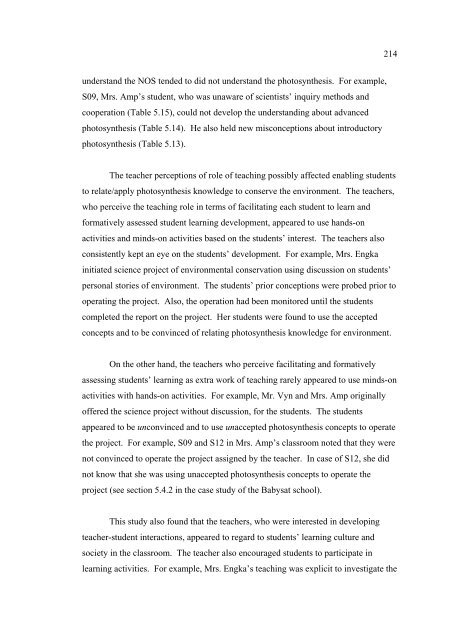an innovative approach
an innovative approach
an innovative approach
Create successful ePaper yourself
Turn your PDF publications into a flip-book with our unique Google optimized e-Paper software.
underst<strong>an</strong>d the NOS tended to did not underst<strong>an</strong>d the photosynthesis. For example,<br />
S09, Mrs. Amp’s student, who was unaware of scientists’ inquiry methods <strong>an</strong>d<br />
cooperation (Table 5.15), could not develop the underst<strong>an</strong>ding about adv<strong>an</strong>ced<br />
photosynthesis (Table 5.14). He also held new misconceptions about introductory<br />
photosynthesis (Table 5.13).<br />
The teacher perceptions of role of teaching possibly affected enabling students<br />
to relate/apply photosynthesis knowledge to conserve the environment. The teachers,<br />
who perceive the teaching role in terms of facilitating each student to learn <strong>an</strong>d<br />
formatively assessed student learning development, appeared to use h<strong>an</strong>ds-on<br />
activities <strong>an</strong>d minds-on activities based on the students’ interest. The teachers also<br />
consistently kept <strong>an</strong> eye on the students’ development. For example, Mrs. Engka<br />
initiated science project of environmental conservation using discussion on students’<br />
personal stories of environment. The students’ prior conceptions were probed prior to<br />
operating the project. Also, the operation had been monitored until the students<br />
completed the report on the project. Her students were found to use the accepted<br />
concepts <strong>an</strong>d to be convinced of relating photosynthesis knowledge for environment.<br />
214<br />
On the other h<strong>an</strong>d, the teachers who perceive facilitating <strong>an</strong>d formatively<br />
assessing students’ learning as extra work of teaching rarely appeared to use minds-on<br />
activities with h<strong>an</strong>ds-on activities. For example, Mr. Vyn <strong>an</strong>d Mrs. Amp originally<br />
offered the science project without discussion, for the students. The students<br />
appeared to be unconvinced <strong>an</strong>d to use unaccepted photosynthesis concepts to operate<br />
the project. For example, S09 <strong>an</strong>d S12 in Mrs. Amp’s classroom noted that they were<br />
not convinced to operate the project assigned by the teacher. In case of S12, she did<br />
not know that she was using unaccepted photosynthesis concepts to operate the<br />
project (see section 5.4.2 in the case study of the Babysat school).<br />
This study also found that the teachers, who were interested in developing<br />
teacher-student interactions, appeared to regard to students’ learning culture <strong>an</strong>d<br />
society in the classroom. The teacher also encouraged students to participate in<br />
learning activities. For example, Mrs. Engka’s teaching was explicit to investigate the
















